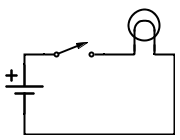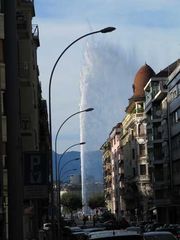Electric circuits, volts amps watts and ohms: Difference between revisions
| Line 21: | Line 21: | ||
==Volts - the pressure is on== | ==Volts - the pressure is on== | ||
[[File:Img_1750a.jpg|180px|thumb|right|High pressure - Jet d' | [[File:Img_1750a.jpg|180px|thumb|right|High pressure - Jet d'Eau, Geneva.]] | ||
(Summary: Low pressure - pic: thumb over inverted bottle of water? High pressure - pic: Geneva Jet d'Eau.) | (Summary: Low pressure - pic: thumb over inverted bottle of water? High pressure - pic: Geneva Jet d'Eau.) | ||
Revision as of 19:59, 23 November 2014
Basic electrical theory every Restarter should know.
(This page is work in progress - comments and update suggestions to the Discussion page only for now please.)
Summary
A knowledge of basic electrical theory is essential for anything more than purely mechanical repairs, and will greatly help in diagnosing faults and working safely.
Electrical Circuits - doing the rounds
An atom consists of a very dense nucleus carrying a positive electric charge surrounded by a cloud of electrons, each having a negative electric charge. Normally, the positive and negative charges cancel exactly. Positive and negative charges attract one another, which is what keeps the electrons bound in an atom. Conversely, like charges repel.
In a metal, some of the electrons are not bound to any particular atom but are free to wander off. Nevertheless, the total of the positive and negative charges remain equal in the lump of metal as a whole. If these electrons move in a steady stream in one direction, e.g. along a piece of wire, we have an electric current.
Since electrons all have a negative charge they repel each other and hence they really hate piling up. So unless they can all move together around a complete circuit and back to where they started, they immediately back up at any obstruction all the way back round the circuit to the other side of the blockage.
The figure shows a very simple circuit consisting of a battery, a switch and a torch bulb. The switch is shown open and so no electricity can pass through it, so none flows anywhere in the circuit. If you close the switch and so complete the circuit, an electric current can flow from one side of the battery, through the switch and the bulb, and back to the other side of the battery.
Electrons carry a negative charge and so are repelled by the negative terminal of the battery and attracted around the circuit to towards the positive terminal. However, in explaining a circuit we often talk about the electricity flowing from positive to negative. Indeed, sometimes an electric current does consist of positively charged atoms moving from positive to negative. Positive to negative or negative to positive, it makes no difference. Whichever best helps you to understand a circuit is the one to use.
Volts - the pressure is on
(Summary: Low pressure - pic: thumb over inverted bottle of water? High pressure - pic: Geneva Jet d'Eau.)
Voltage is like the electrical pressure. If you put your thumb over the bathroom tap and turn it on, you can probably stop the flow because you're only holding back the pressure of the water from the tank in the loft a few feet above your head. If you try the same at the kitchen tap, probably fed directly off the water main, you're likely to get very wet because the pressure is much higher. The Jet d'Eau at Geneva uses an enormous pressure to create a fountain several hundred feet high. Imagine trying to stop that with your thumb!
In the circuit we looked at above the current is driven round the circuit by a battery. That might be an AA cell, which doesn't push very hard. We measure the pressure in volts, of which an AA cell will give us around 1.5, and so it will be labelled 1.5v. If you replaced the battery in our circuit by a source of a few thousand volts, the pressure would be so great that the electricity would form a spark in order to jump over the open switch. And the bulb probably wouldn't last long either!
Mains electricity comes at 240v, which is enough to do useful work but not so much as to jump across a switch or break out anywhere else it's not meant to go.
Amps - go with the flow
Small flow - pic: dripping tap?
Large flow - pic: Amazon?
Watts - feel the power
Volts x Amps - large voltage or large current.
Illustrations?
Ohms - resistance isn't futile
Volts per amp
Illustration?
Safety
Consider whether your page should include a specific section on safety, if for example it deals with mains-powered equipment or high voltages, or if special care is required in handling hot or sharp tools, or hazardous substances.
References
External links
- External links as bullet points


